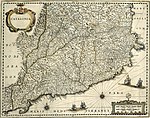
Back Comtats catalans Catalan Katalanische Grafschaften German Condados catalanes Spanish Kataluniako konderriak Basque Comtés catalans French Condados cataláns Galician Contee catalane Italian Comitatus Catalaunici Latin Catalaanse graafschappen Dutch Condados catalães Portuguese
| History of Catalonia |
|---|
 |
| Timeline |
The Catalan counties (Catalan: Comtats Catalans, IPA: [kumˈtats kətəˈlans]) were those surviving counties of the Hispanic March and the southernmost part of the March of Gothia that were later united to form the Principality of Catalonia.
In 778, Charlemagne led the first military Frankish expedition into Hispania to create the Hispanic March, a military buffer zone between the Emirate of Córdoba of Al-Andalus and the Frankish Empire. The territory that he subdued would in later centuries be the kernel of Catalonia (not yet known like that since the first written mention of Catalonia is in 1113). In 781, Charlemagne made his 3-year-old son Louis the Pious (778 – 840) king of Aquitaine, who was sent there with regents and a court in order to secure the southern border of his kingdom against the Arabs and Moors and to expand southwards into Muslim territory.
These counties were originally feudal entities ruled by a small military elite. Counts were appointed directly by and owed allegiance to the Carolingian (Frankish) emperor. The appointment to heirs could not be taken for granted. However, with the rise of the importance of the Bellonids and strong figures among them such as, Sunifred (fl. 844–848) and Wilfred the Hairy (c.870-897), and the weakening of Carolingian royal power, the appointment of heirs eventually become a formality. This trend resulted in the counts becoming de facto independent of the Carolingian crown under Borrell II in 987, starting since, to call themselves and to be known as dei gratia comes (counts by the grace of god) and dux catalanensis (Catalan dukes) or even Hispaniae subjogator (attorney of Hispania) and Propugnator et murus christiani populi (wall and defender of the Christian folk).
The many counties (aside from the counties of County of Pallars, County of Urgell and County of Empuries) were to be soon absorbed into the County of Barcelona. A Count of Barcelona, prince Ramon Berenguer IV, married princess Petronilla of Aragon of the Kingdom of Aragon in 1150, uniting as equals the County of Barcelona and the Kingdom of Aragon. Thus, their son, Alfonso II of Aragon, became the first king of the Crown of Aragon, ruling over both the Catalans and the Aragonese.
© MMXXIII Rich X Search. We shall prevail. All rights reserved. Rich X Search